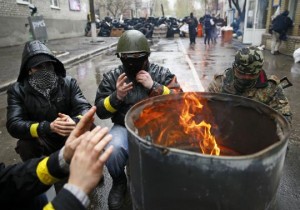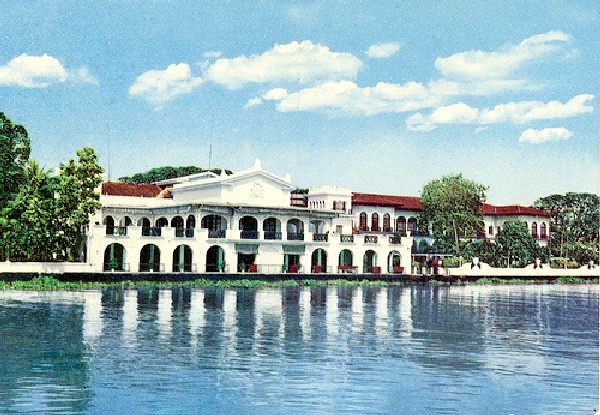
(Reuters) – The United Nations Security Council held an emergency session on Sunday night to discuss the escalating crisis in Ukraine, just hours before a deadline by Kiev for pro-Russian separatists to disarm by Monday morning or face a “full-scale anti-terrorist operation” by its armed forces.
The Council began meeting at 8 p.m. at Russia’s request after Moscow called Kiev’s plans to mobilize the army to put down a rebellion by pro-Russian militants in eastern Ukraine “criminal.”
Britain’s U.N. ambassador said Russia had massed tens of thousands of well-equipped troops near the Ukrainian border in addition to the 25,000 troops it recently moved into Crimea, which Moscow seized last month.
“Satellite images show that there are between 35,000 and 40,000 Russian troops in the vicinity of the border with Ukraine equipped with combat aircraft, tanks, artillery and logistical support units,” Ambassador Mark Lyall Grant said.
“This is in addition to the 25,000 Russia troops based illegally in Crimea,” Lyall Grant added in his speech during the U.N. emergency meeting.
Angered by the death of a state security officer and the wounding of two comrades near the flashpoint eastern city of Slaviansk, Ukrainian acting president Oleksander Turchinov gave rebels occupying state buildings until 0600 GMT (2 a.m. EDT) to lay down their weapons.
“The National Security and Defense Council has decided to launch a full-scale anti-terrorist operation involving the armed forces of Ukraine,” Turchinov said in an address to the nation.
He blamed Russia, which annexed Ukraine’s Crimea region when Moscow-backed former president Viktor Yanukovich fled after months of pro-Western protests, for being behind the rash of rebellions across Russian-speaking towns in eastern Ukraine.
“We will not allow Russia to repeat the Crimean scenario in the eastern regions of Ukraine,” Turchinov said.
The deadline and the standoff with Russian troops at the border have raised fears of a military confrontation with Moscow.
The head of Ukraine’s state security service (SBU) said government forces would respond ruthlessly if pro-Russian separatists opened fire.
“If they open fire, we will annihilate them. There should be no doubt about this,” Valentyn Nalyvaichenko said in a televised interview.
Russia’s Foreign Ministry called the planned military operation a “criminal order” and said the West should bring its allies in Ukraine’s government under control.
“It is now the West’s responsibility to prevent civil war in Ukraine,” the ministry said in a statement.
The 15-nation council has held numerous emergency meetings on Ukraine but has been incapable of taking any concrete action because of Russia’s sharp disagreements with the United States and Europe.
Earlier, the American ambassador to the U.N., Samantha Power, said on ABC’s “This Week” that the United States was prepared to step up sanctions against Moscow if pro-Russian military actions in eastern Ukraine continued.
“The president has made clear that, depending on Russian behavior, sectoral sanctions in energy, banking, mining could be on the table, and there’s a lot in between,” she added.
Ukraine has repeatedly said the rebellions are inspired and directed by the Kremlin. But action to dislodge the armed militants risks tipping the stand-off into a new, dangerous phase as Moscow has warned it will protect the region’s Russian-speakers if they come under attack.
One Ukrainian state security officer was killed and five were wounded on the government side in Sunday’s operation in Slaviansk, Interior Minister Arsen Avakov said. “There were dead and wounded on both sides,” he wrote on his Facebook page.
WELL ORGANISED ATTACKERS
The separatists are holed up in the local headquarters of the police and of the state security service, while others have erected road blocks around Slaviansk, about 150 km (90 miles) from the Russian border.
Kiev accuses the Kremlin of trying to undermine the legitimacy of presidential elections on May 25 that aim to set Ukraine back on a normal path after months of turmoil.
However, Russian Foreign Minister Sergei Lavrov said Kiev was “demonstrating its inability to take responsibility for the fate of the country” and warned that any use of force against Russian speakers “would undermine the potential for cooperation”, including talks due to be held on Thursday between Russia, Ukraine, the United States and the European Union.
Relations between Russia and the West are at their worst since the Cold War, due to the crisis that began when Moscow-backed Yanukovich was pushed out by popular protests in February.
Moscow then annexed Crimea from Ukraine, saying the Russian population there was under threat. Some Western governments believe the Kremlin is preparing a similar scenario for eastern Ukraine, something Moscow has strenuously denied.
In Kramatorsk, about 15 km (9 miles) south of Slaviansk, gunmen seized the police headquarters after a shootout with police, a Reuters witness said.
The attackers were a well-organized unit of more than 20 men, wearing matching military fatigues and carrying automatic weapons, who had arrived by bus. Video footage showed the men taking orders from a commander. Their identity was unclear.
Their level of discipline and equipment was in contrast to the groups which have occupied buildings so far in Ukraine. They have been mostly civilians formed into informal militias with mismatched uniforms.
In Washington, the U.S. State Department said pro-Russian militants seizing government buildings in six cities in eastern Ukraine on Saturday was an orchestrated operation reminiscent of those conducted in Crimea before it was annexed by Russia.
“Many of the militants were outfitted in bullet-proof vests and camouflage uniforms with insignia removed and carrying Russian-origin weapons,” it said in a note entitled “Evidence of Russian Support for Destabilization of Ukraine.”
“These operations bear many similarities to those that were carried out in Crimea in late February and culminated in Russia’s illegal military intervention and purported annexation of Crimea,” the State Department note said.
NATO Secretary-General Anders Fogh Rasmussen also expressed concern about similarities in the appearance of some rebels to that of the Russian troops who seized control in Crimea.
Calling on Russia to pull back its large number of troops, including special forces, from the area around Ukraine’s border, he said in a statement: “Any further Russian military interference, under any pretext, will only deepen Russia’s international isolation.”
NATO has effectively ruled out military action over Ukraine, which lies outside the Western alliance. However, Washington and NATO leaders have made clear they would defend all 28 member states, including former Soviet republics in the Baltic that are seen as the most vulnerable to Russian pressure.
NATO allies have beefed up their air and sea firepower in eastern Europe. The alliance has also cut off cooperation with Russia and stepped up work with Ukraine, including advising its military on reforms and promising to increase joint exercises.
With EU foreign ministers due to discuss the crisis in Luxembourg on Monday, Britain called on Moscow to disown the rebels.
The crisis over Ukraine could trigger a “gas war”, disrupting supplies of Russian natural gas to customers across Europe. Moscow has said it may be forced to sever deliveries to Ukraine – the transit route for much of Europe’s gas – unless Kiev settles its debts.
For now, though, the focus of the crisis is in eastern Ukraine, the country’s industrial heartland, where many people feel a close affinity with neighboring Russia.








